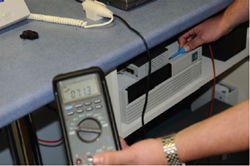Many modern medical devices consume only small amounts of power. In many cases this power comes from rechargeable batteries. Nevertheless, the mains power supply needed to either power the device or recharge the batteries ends up being quite large and heavy because of the need to include the mains transformer and smoothing capacitors, and to provide some means of getting rid of the heat that is generated.

Most of the small medical devices commonly in use now use switch mode power supplies
(SMPS) which are smaller, lighter, and generate much less heat than conventional
transformers, and can also give very accurate control of output voltage. There are,
however, some disadvantages in using SMPSs, particularly in large establishments
where there may be a very large number of these devices in use. The SMPS only draws
current close to the peak of the input sine wave. This tends to generate high frequency
interference, unless efficient input filters are incorporated into the design.
The simplest types of SMPS do not include power factor correction, which will also result
in harmonic distortion, which can cause problems where a large number of these devices
are in use.
The design of many SMPSs does not include an earth connection, so that any equipment
supplied by the SMPS will be floating. Stray capacitance will result in the outputs being at
about 50% of the mains input voltage. The amount of current that can flow to earth will be
low, since it is due to the stray capacitance, but in some cases it can be sufficient to give
a noticeable ‘buzz’ if the exposed conductive surfaces of any connected equipment are
touched. Figure 1 shows an example of a USB hub that has a touch voltage of 71.3V on
the metal enclosure. This would not be a problem, except where the touch voltage could
be applied to a patient.
To view the full article, click on the PDF attachment below.